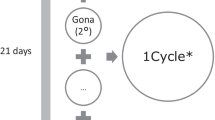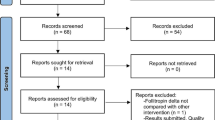Abstract
Purpose
The purpose of this study was to identify trends in gonadotropin therapy in patients undergoing in vitro fertilization (IVF) treatment worldwide.
Methods
Retrospective evaluation utilizing the results of a Web-based survey, IVF-Worldwide (www.IVF-worldwide.com) was performed.
Results
Three hundred fourteen centers performing a total of 218,300 annual IVF cycles were evaluated. Respondents representing 62.2% of cycles (n = 135,800) did not believe there was a difference between urinary and recombinant gonadotropins in terms of efficacy and live birth rate. Of the respondents, 67.3% (n = 146,800) reported no difference between recombinant and urinary formulations in terms of short-term safety and risk of ovarian hyperstimulation syndrome. In terms of long-term safety using human urinary gonadotropins, 50.6% (n = 110,400) of respondents believe there are potential long-term risks including prion disease. For 95.3% of units (n = 208,000), the clinician was the decision maker determining which specific gonadotropins are used for IVF. Of the units, 62.6% (n = 136,700) identified efficacy as the most important factor in deciding which gonadotropin to prescribe. While most (67.3%, n = 146,800) were aware of new biosimilar recombinant FSH products entering the market, 92% (n = 201,000) reported they would like more information. A fraction of respondents (25.6%, n = 55,900) reported having experience with these new products, and of these, 80.3% (n = 46,200) reported that they were similar in efficacy as previously used gonadotropins in a similar patient group.
Conclusions
Respondents representing the majority of centers do not believe a difference exists between urinary and recombinant gonadotropins with respect to efficacy and live birth rates. While many are aware of new biosimilar recombinant FSH products entering the market, over 90% desire more information on these products.
Similar content being viewed by others
References
Van Wely M, Kwan I, Burt AL, Thomas J, Vail A, Van der Veen F, Al-Inany HG. Recombinant versus urinary gonadotrophin for ovarian stimulation in assisted reproductive technology cycles. A cochrane review. Hum Reprod Update. 2012;18(2):111. doi:10.1093/humupd/dmr048.
Patil M. Gonadotrophins: the future. J Hum Reprod Sci. 2014;7(4):236–48. doi:10.4103/0974-1208.147490.
Practice T, Medicine R. Gonadotropin preparations: past, present, and future perspectives. Fertil Steril. 2008;90(5):S13–20. doi:10.1016/j.fertnstert.2008.08.031.
Bassett RM, Driebergen R. Continued improvements in the quality and consistency of follitropin alfa, recombinant human FSH. Reprod BioMed Online. 2005;10(2):169–77.
Santi D, Simoni M. Biosimilar recombinant follicle stimulating hormones in infertility treatment. Expert Opin Biol Ther. 2014;14(10):1399–409. doi:10.1517/14712598.2014.925872.
Keene JL, Matzuk MM, Otani T, Fauser BC, Galway AB, Hsueh AJ, Boime I. Expression of biologically active human follitropin in Chinese hamster ovary cells. J Biol Chem. 1989;264(9):4769–75.
Barrenetxea G. Iatrogenic prion diseases in humans: an update. Eur J Obstet Gynecol Reprod Biol. 2012;165(2):165–9. doi:10.1016/j.ejogrb.2012.08.014.
Revelli A, Pettinau G, Basso G, Carosso A, Ferrero A, Dallan C, Canosa S, Gennarelli G, Guidetti D, Filippini C, Benedetto C. Controlled ovarian stimulation with recombinant-FSH plus recombinant-LH vs. human menopausal gonadotropin based on the number of retrieved oocytes: results from a routine clinical practice in a real-life population. Reprod Biol Endocrinol: RB&E. 2015;13(1):77. doi:10.1186/s12958-015-0080-6.
Aboulghar M, Saber W, Amin Y, Aboulghar M, Mansour R, Serour G. Prospective, randomized study comparing highly purified urinary follicle-stimulating hormone (FSH) and recombinant FSH for in vitro fertilization/intracytoplasmic sperm injection in patients with polycystic ovary syndrome. Fertil Steril. 2010; doi:10.1016/j.fertnstert.2010.01.051.
Baker VL, Fujimoto VY, Kettel LM, Adamson GD, Hoehler F, Jones CE, Soules MR. Clinical efficacy of highly purified urinary FSH versus recombinant FSH in volunteers undergoing controlled ovarian stimulation for in vitro fertilization: a randomized, multicenter, investigator-blind trial. Fertil Steril. 2009;91(4):1005–11. doi:10.1016/j.fertnstert.2008.01.064.
Smitz J, Wolfenson C, Chappel S, Ruman J. Follicle-stimulating hormone: a review of form and function in the treatment of infertility. Reprod Sci. 2015; doi:10.1177/1933719115607992.
Roger SD, Mikhail A. Biosimilars: opportunity or cause for concern? J Pharm Pharm Sci. 2007;10(3):405–10.
Orvieto R, Seifer DB. Biosimilar FSH preparations—are they identical twins or just siblings? Reprod Biol Endocrinol. 2016;14(1):32. doi:10.1186/s12958-016-0167-8.
Vaisbuch E, Leong M, Shoham Z. Progesterone support in IVF: is evidence-based medicine translated to clinical practice? A worldwide Web-based survey. Reprod BioMed Online. 2012;25(2):139–45. doi:10.1016/j.rbmo.2012.04.005.
Vernazza PSE, De Sutter P. ESHRE position statement concerning prion detection in urinary gonadotropin formulations. [Website]. Available from: http://www.eshre.eu/Guidelines-and-Legal/ESHRE-Position-Papers.aspx. Accessed 15 May 2016.
Strowitzki T, Kuczynski W, Mueller A, Bias P. Randomized, active-controlled, comparative phase 3 efficacy and safety equivalence trial of Ovaleap(R) (recombinant human follicle-stimulating hormone) in infertile women using assisted reproduction technology (ART). Reprod Biol Endocrinol. 2016;14:1. doi:10.1186/s12958-015-0135-8.
Rettenbacher M, Andersen AN, Garcia-Velasco JA, Sator M, Barri P, Lindenberg S, Van Der Ven K, Khalaf Y, Bentin-Ley U, Obruca A, Tews G, Schenk M, Strowitzki T, Narvekar N, Sator K, Imthurn B. A multi-centre phase 3 study comparing efficacy and safety of Bemfola® versus Gonal-f® in women undergoing ovarian stimulation for IVF. Reprod BioMed Online. 2015;30(5):504–13. doi:10.1016/j.rbmo.2015.01.005.
Author information
Authors and Affiliations
Corresponding author
Appendix
Appendix
Rights and permissions
About this article
Cite this article
Christianson, M.S., Shoham, G., Tobler, K.J. et al. Use of various gonadotropin and biosimilar formulations for in vitro fertilization cycles: results of a worldwide Web-based survey. J Assist Reprod Genet 34, 1059–1066 (2017). https://doi.org/10.1007/s10815-017-0952-0
Received:
Accepted:
Published:
Issue Date:
DOI: https://doi.org/10.1007/s10815-017-0952-0




